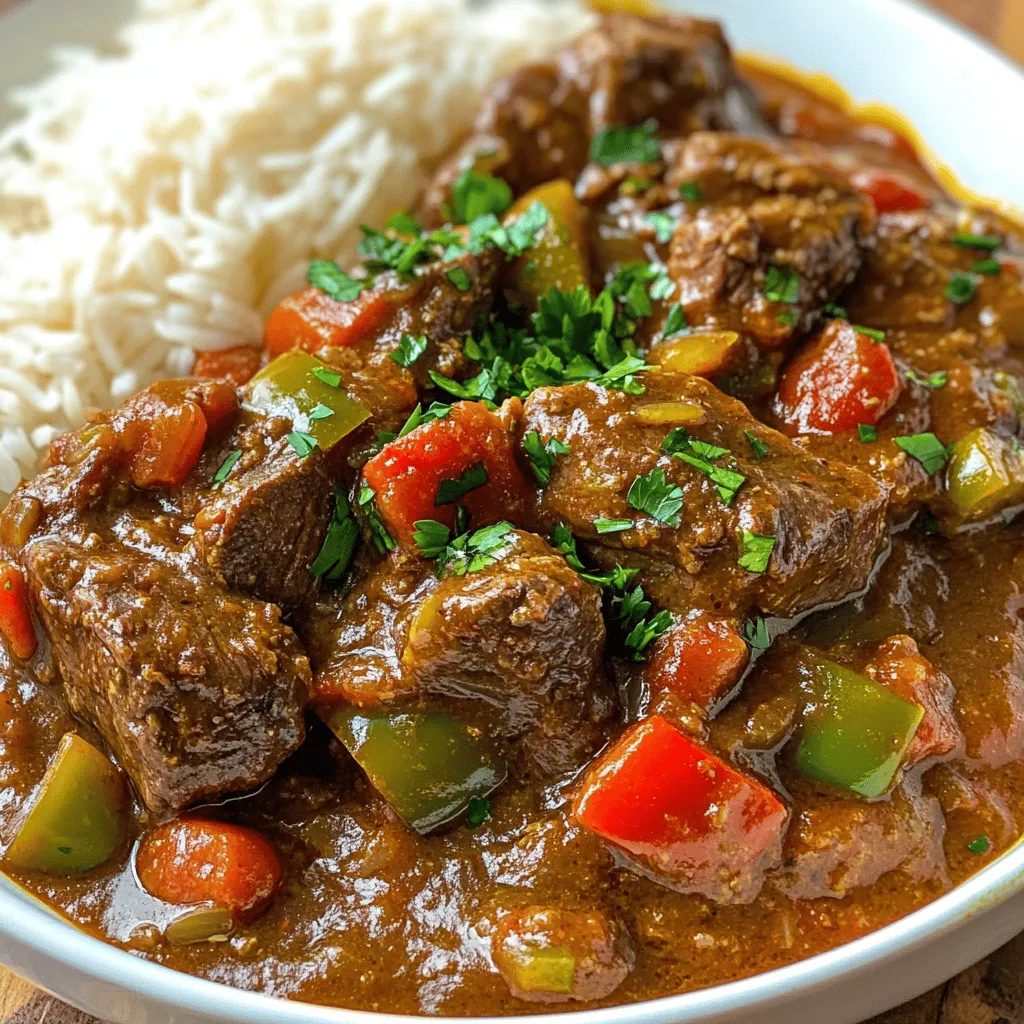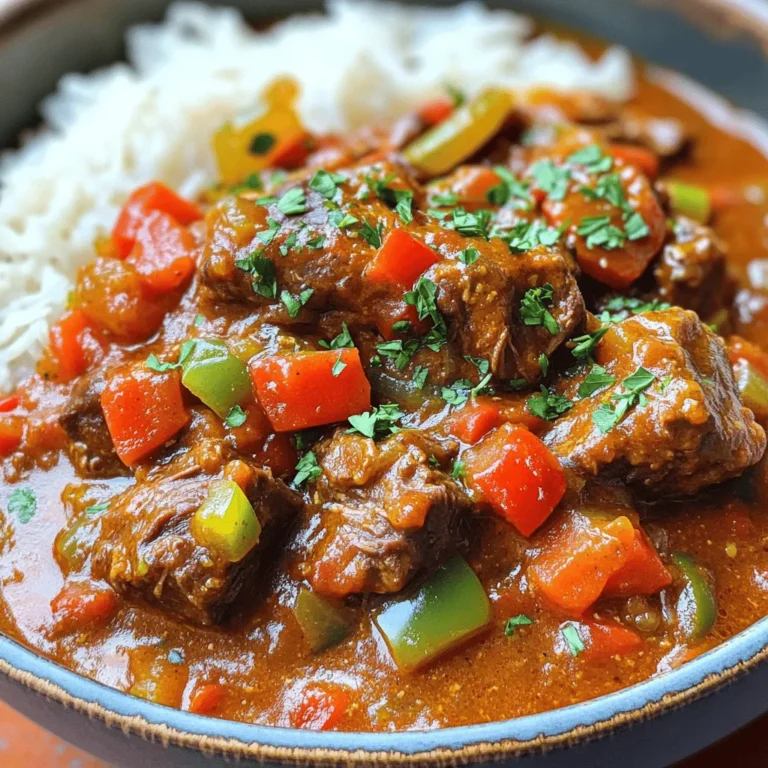Are you ready to dive into the rich and flavorful world of Nigerian Beef Stew? This comfort dish warms the heart, with tender beef and spices that dance on your palate. In this post, I’ll guide you through the ingredients, step-by-step instructions, and tricks to achieve the perfect bowl. Whether you’re a seasoned cook or a kitchen newbie, you’ll discover how to create this delicious stew that’s perfect for any meal. Let’s get started!
Ingredients
Complete List of Ingredients
– 1.5 lbs beef (cut into bite-sized cubes)
– 1 large onion (finely chopped)
– 2 red bell peppers (seeds removed and blended)
– 1 green bell pepper (seeds removed and blended)
– 2 medium ripe tomatoes (blended)
– 4 cloves garlic (minced)
– 1 inch piece of fresh ginger (finely grated)
– 1/4 cup vegetable oil (for sautéing)
– 2 tablespoons tomato paste (for added depth)
– 2 teaspoons ground coriander (for warmth)
– 1 teaspoon curry powder (for flavor)
– 1 teaspoon dried thyme (for aroma)
– 1-2 fresh chili peppers (finely chopped, adjust for heat preference)
– 4 cups beef broth (for richness)
– Salt (to taste)
– Fresh parsley or cilantro (chopped, for garnish)
When making Nigerian beef stew, the right ingredients make all the difference. The beef should be well-marbled. This fat adds flavor and keeps the meat tender. Fresh vegetables like onions, bell peppers, and tomatoes are key. They create a rich base.
For spices, ground coriander and curry powder bring warmth. Fresh ginger and garlic add zing. You can adjust the chili peppers for heat. Add salt to taste for balance.
Garnish with fresh parsley or cilantro. This adds a nice color and freshness. Each ingredient plays a role in creating a stew that is rich and comforting.
Step-by-Step Instructions
Preparing the Vegetables
Start by sautéing the onions. Heat vegetable oil in a large pot. Add the finely chopped onion and cook for about 5-7 minutes. You want them soft and golden. Next, add minced garlic and grated ginger. Sauté for another 2-3 minutes. The smell will be amazing!
Now, blend the red and green bell peppers with the ripe tomatoes. The mix should be smooth. Pour this blend into the pot. Cook for about 10-15 minutes, stirring often. You want the mixture to thicken and lose its raw taste.
Cooking the Beef
For the beef, cut it into bite-sized cubes. Add these to the pot after the vegetable mix has cooked down. Brown the beef cubes on all sides, stirring gently. This step gives the meat a nice texture.
To ensure your beef stays tender, don’t overcrowd the pot. If you need to, cook in batches. Season the meat with salt and chopped chili peppers for heat. Adjust the chili based on your taste.
Simmering the Stew
Once the beef is browned, it’s time to simmer. Add the blended spices and 4 cups of beef broth to the pot. Make sure the meat is fully submerged. Increase the heat until it boils, then reduce it to a gentle simmer.
Cover the pot and let it cook for 1 to 1.5 hours. Keep an eye on the stew. Stir occasionally to prevent sticking. The beef should be fork-tender when done. Taste it before serving. If needed, add more salt or spices for flavor.
This process brings all the rich and cozy flavors together.
Tips & Tricks
Achieving the Best Flavor
Using fresh ingredients is key to a great Nigerian beef stew. Fresh beef gives the stew a rich taste. Fresh spices and herbs boost the dish’s aroma. Always choose ripe tomatoes and colorful peppers. These enhance the stew’s overall flavor and color.
To deepen the flavor, sauté your onions until they caramelize. This step adds sweetness and richness. Adding the garlic and ginger next brings warmth and depth. Don’t rush; allow these ingredients to meld well. The blend of peppers and tomatoes should cook until thick. This reduces raw taste and builds a good base.
Common Mistakes to Avoid
One common mistake is overcooking or undercooking the beef. Overcooked beef gets tough and dry. You want the meat tender but not falling apart. Cook it slowly, letting it simmer until it is fork-tender.
Balancing spices correctly is also important. Using too much can overpower the dish. Start with less and taste as you go. You can always add more, but it’s hard to fix a dish with too much spice.
Serving Suggestions
Nigerian beef stew pairs well with fluffy white rice or crusty bread. These sides soak up the delicious sauce. For a colorful plate, serve with steamed vegetables or a fresh salad.
For presentation, serve the stew in deep bowls. Garnish with fresh parsley or cilantro for a pop of color. You can also add a slice of lime on the side for a zesty twist. This not only adds beauty but also a fresh taste.

Variations
Ingredient Substitutions
You can make Nigerian beef stew with other proteins. Chicken is a great choice. It cooks faster and is lighter. Goat meat also works well. It adds a unique flavor.
For a vegetarian option, use mushrooms or lentils. They soak up the stew’s rich taste. You can replace beef broth with vegetable broth too. This keeps the stew hearty and delicious.
Flavor Variations
Spice levels can change how the stew tastes. If you like it mild, use fewer chili peppers. For more heat, add extra. You can also try different spices. Paprika or smoked paprika adds a nice kick.
Adding vegetables can boost nutrition. Carrots and potatoes make great additions. They add sweetness and texture. Just chop them up and throw them in the pot when you add the beef.
Regional Twists
Nigerian beef stew varies by region. In the north, they might use more spices like cumin. In the south, they may use coconut milk for creaminess. Each region has its own unique twist.
Local spices also change the flavor. For example, you can use locust beans for a distinct taste. This adds a depth that makes the stew truly special.
Storage Info
Refrigeration Guidelines
To store leftovers of Nigerian beef stew, let it cool first. Then, transfer it into an airtight container. Make sure to seal it well to keep it fresh. You can store the stew in the fridge for up to 3-4 days. This allows you to enjoy the rich flavors later.
Freezing Instructions
If you want to keep the stew longer, freezing is a great option. Use freezer-safe containers or bags. Make sure to leave some space for the stew to expand. This will help avoid spills. You can freeze the stew for about 3 months. When you are ready to eat, thaw it overnight in the fridge.
Reheating Methods
Reheating the stew can be simple. For the best flavor, use the stovetop. Pour the stew into a pot over medium heat. Stir often to make sure it heats evenly. If you use a microwave, place it in a microwave-safe bowl. Heat in short bursts, stirring in between. This method works, but the stovetop keeps the flavors better.
FAQs
What is Nigerian Beef Stew?
Nigerian Beef Stew is a rich and hearty dish. It comes from Nigeria and reflects its vibrant culture. The stew uses spices and fresh ingredients to create deep flavors. It often includes beef, tomatoes, and peppers. This dish is a staple in many Nigerian homes and is loved worldwide.
Can I make this dish ahead of time?
Yes, you can make Nigerian Beef Stew ahead of time. It actually tastes better the next day! Store it in an airtight container in the fridge. Reheat it gently on the stove when you’re ready to eat. This saves time and lets the flavors meld.
What to serve with Nigerian Beef Stew?
Nigerian Beef Stew pairs well with several sides. Here are some popular options:
– Fluffy white rice
– Nigerian jollof rice
– Pounded yam
– Plantains
– Crusty bread
These sides soak up the rich sauce and make your meal complete.
Is Nigerian Beef Stew spicy?
Nigerian Beef Stew can be spicy, but you control the heat. The stew uses fresh chili peppers, but you can adjust the amount. For a milder stew, use fewer peppers or remove the seeds. If you love spice, add more chili peppers for extra heat.
How to make the stew thicker?
To thicken Nigerian Beef Stew, there are a few easy methods:
– Simmer it longer to reduce the liquid.
– Add a spoon of tomato paste during cooking.
– Mix in a cornstarch slurry (cornstarch and water) for quick thickening.
These methods will help you achieve the desired thickness for your stew.
Nigerian Beef Stew is a rich dish full of flavor and history. We covered key ingredients, detailed cooking steps, and helpful tips. Using fresh herbs and proper techniques makes a big difference. I shared ideas for variations and storage too.
With practice, you can master this dish and impress your friends and family. Enjoy the process and make the dish your own. Cooking is fun, and each meal is a chance to learn. Happy cooking!


